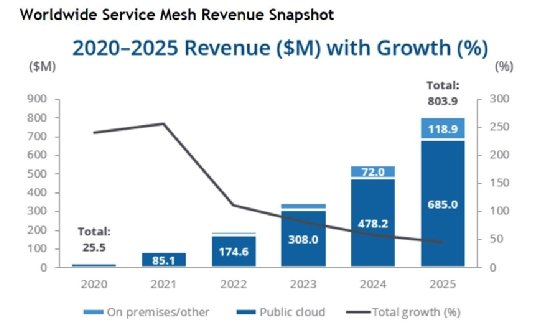
Getty Images
Solo.io folds API gateway in with Istio service mesh
Solo.io is among the service mesh vendors aligning the emerging tech with existing network management as enterprise adoption expands.
Service mesh is poised for mainstream enterprise growth and IT vendors have begun to align it with more familiar cloud network management tools in a bid to capture customers.
Among those vendors is Solo.io, which this week blended its Gloo Edge API gateway with its Gloo Mesh packaged version of open source Istio. The two products previously worked together, but this week's release builds Gloo Edge directly into the Gloo Mesh control plane to simplify management and improve performance.
API gateways arose in the early days of cloud computing to manage traffic and security among web-based apps that communicate through REST APIs. Service mesh is an evolution of those gateways to support microservices apps, distributing traffic management and security functions to a group of software components called sidecars, which are deployed within each Pod in a Kubernetes container cluster.
Kubernetes also requires a way to allow microservices to communicate with apps and services hosted outside the cluster, especially as multi-cluster and multi-cloud management grow more common in enterprise IT. Service mesh early adopters often use Kubernetes ingress controllers to handle inbound traffic, while managing API traffic through a gateway, but Solo.io's release this week consolidates those layers.
"With any [separate] API gateway, you have two control planes to upgrade separately ... now it's less code, and you don't need to do the same thing twice," said Idit Levine, CEO of Solo.io. "It's also a little bit better performance, because a lot of people use ingress [controllers] and the API gateway as well, and now we took one hop out."
Gloo Mesh Gateway, the newly integrated gateway and service mesh product, also bundles in the Gloo Portal, which extends support for legacy applications that use the Simple Object Access Protocol (SOAP) for messaging. SOAP has fallen out of favor compared with REST, but many enterprise applications still use it. This integration, based on an extension to the open source Envoy sidecar, will allow the service mesh to accommodate those apps, Levine said.
Finally, Solo.io updated some features of its Gloo Mesh Enterprise packaged Istio product, adding support for automated control plane security certificate rotation and integration with external certificate providers. Solo.io will also backport fixes to critical vulnerabilities to four previous versions of open source Istio, rather than the previous three, meaning conservative enterprises don't have to upgrade between Istio versions as quickly to avoid security vulnerabilities.

Service mesh DIY gives way to vendor packages
While service mesh tech generated plenty of buzz in the industry over the last two years, use among enterprise IT shops remained embryonic, according to a market forecast report released this month by analyst firm IDC.
"Service meshes have been deployed by digital natives and cloud providers for a few years now, but those were built in DIY mode using free open source software by relatively sophisticated platform teams," according to the report. "The early mainstream and those who will follow will have different types of organizations, with different requirements, and a DIY approach will be impractical for most of them."
Service mesh vendors have sprung up to eliminate the DIY toil for enterprises that want to use service mesh without a steep learning curve. These vendors include other Istio specialists such as Tetrate, which offers SaaS versions of their products; Solo.io plans its own service mesh SaaS called Gloo Cloud.
There are also service mesh competitors to Istio, such as Kong, Linkerd and HashiCorp Consul, that seek early enterprise mainstream appeal with hosted cloud services and easy-to-use features. Finally, Kubernetes platform vendors, including VMware, Red Hat and the major cloud service providers, also offer packaged and hosted versions of service mesh.
This last category of products, which usually offer integrations and support not just for service mesh but for Kubernetes itself, along with other open source cloud-native projects such as Knative event-driven computing and Tekton pipelines, will lead the growth in this market over the next four years, the IDC report predicts.
"Red Hat has a brand-equity edge as well as a full-stack approach to Kubernetes," said Brad Casemore, an IDC analyst and one of the authors of the market forecast report. "They tend to see more deal flow than the smaller players."
Still, Solo.io's update this week aligns with several of the recommendations the report includes for service mesh vendors, including an emphasis on security features and integration with existing network management tools, including API gateways.
"Solo's strategic focus is potentially lucrative," Casemore said. "You can see how they're trying to put all the pieces together, including multi-cluster, multi-mesh, and integration with the API gateway."
Beth Pariseau, senior news writer at TechTarget, is an award-winning veteran of IT journalism. She can be reached at [email protected] or on Twitter @PariseauTT.





